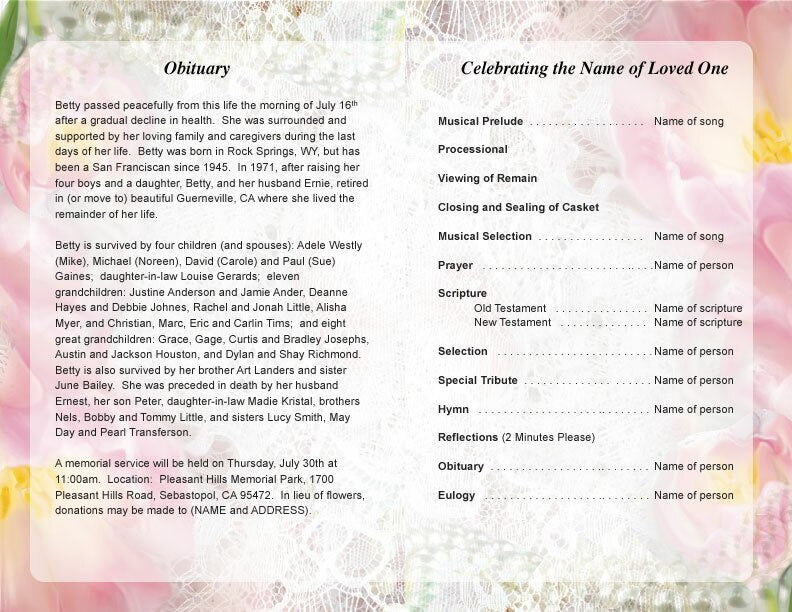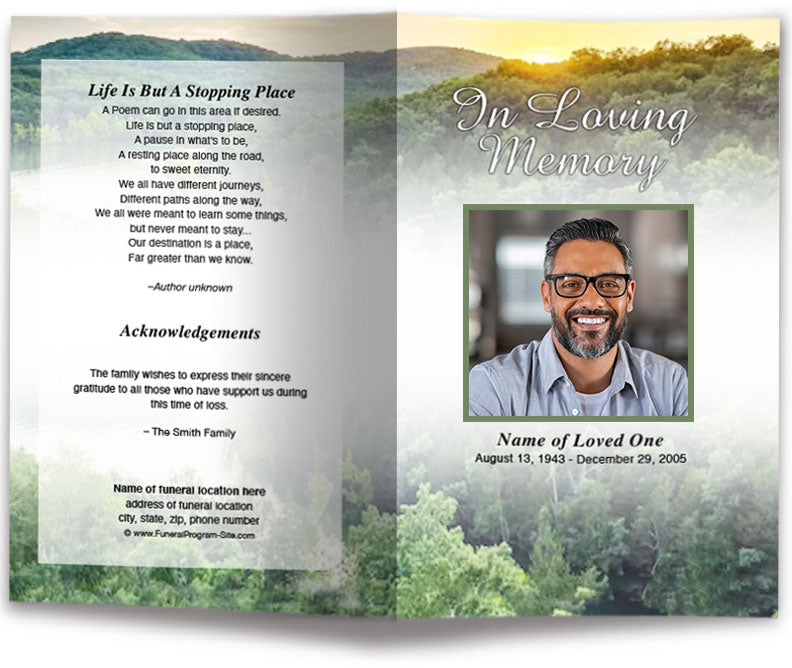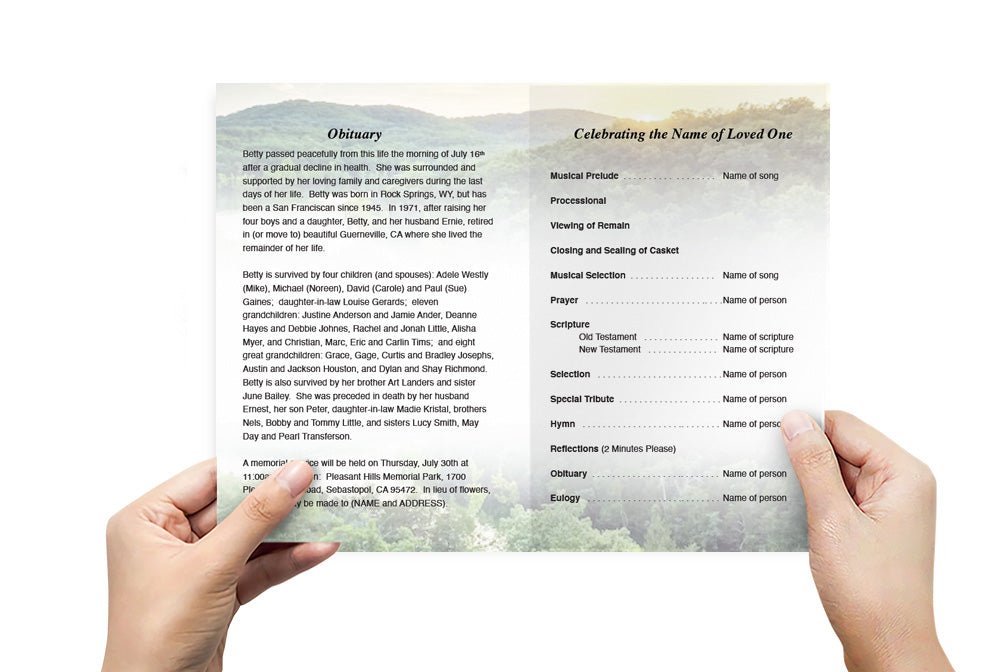What Essential Information Should Be Included in the Funeral Program?

A funeral program is one of the most important elements of a memorial or celebration-of-life service. It serves as a guide for attendees, helping them follow the ceremony, while also becoming a cherished keepsake that preserves memories of a loved one. But what details should a funeral program include to make it both functional and meaningful? Striking the right balance between practical information and personal touches is key.
In this article, we will explore the essential information every funeral program should contain, why each section matters, and how using professional templates from trusted providers like The Funeral Program Site can simplify the process.
For examples and design resources, visit:
Why Is a Funeral Program Important?
A funeral program is more than a piece of paper—it provides structure for the service and serves as a tangible memory for family and friends. Here’s why it matters:
-
Organizes the Ceremony: A clear layout ensures guests know the order of events and can follow along easily.
-
Offers Comfort: Reading poems, scripture, or tributes helps attendees reflect during the service.
-
Acts as a Keepsake: Programs are often saved as mementos, preserving the legacy of the loved one.
-
Acknowledges Support: Families can use the program to express gratitude to those who offered help.
Including essential details ensures the program is both informative and heartfelt.
Essential Information to Include in a Funeral Program
While designs and styles vary, certain key elements appear in nearly every funeral program. Let’s break them down:
1. Front Cover Details
The front cover sets the tone for the entire program. Common elements include:
-
Full name of the deceased
-
Birth and death dates
-
A photograph (usually a favorite portrait)
-
Title of the service (e.g., “A Celebration of Life,” “In Loving Memory”)
-
Date, time, and location of the service
Adding a serene background image or floral design enhances the visual appeal and reflects the loved one’s personality.
2. Order of Service
The order of service provides attendees with a roadmap for the ceremony. It typically lists:
-
Welcome or opening remarks
-
Prayer or scripture reading
-
Musical selections
-
Eulogy
-
Tributes or speeches
-
Closing remarks and prayer
-
Recessional song
Whether the service is religious, non-religious, or a life celebration, organizing these details in sequence helps everything flow smoothly.
3. Obituary or Life Story
Including an obituary or short biography allows guests to reflect on the life being celebrated. Key details to include:
-
Place and date of birth
-
Education and career highlights
-
Family relationships
-
Accomplishments and hobbies
-
Community involvement
-
Surviving family members
Keep the tone warm and personal to make this section more meaningful.
4. Photos
Photos bring memories to life. Most programs include:
-
A cover photo of the deceased
-
A small photo on the back cover or inside pages
-
Optional photo collages for multi-page programs
Choose clear, high-resolution images for best printing results.
5. Poems, Scriptures, or Quotes
Adding an inspirational message provides comfort and sets the tone for reflection. Popular options include:
-
Religious verses
-
Classic poems about life and love
-
Personalized quotes that capture the essence of the loved one
6. Acknowledgments
This section allows families to thank those who offered support through flowers, cards, or presence at the service. It often includes:
-
A short message of gratitude
-
Names of individuals or organizations to acknowledge
7. Service Details
Include any important logistical details, such as:
-
Burial or interment location
-
Reception venue and time
-
Directions or special instructions (e.g., “Reception to follow in the fellowship hall”)
8. Pallbearers and Officiant Names
Listing these names is traditional in many programs and serves as a gesture of appreciation.
9. Back Cover
The back cover often includes:
-
A closing prayer or quote
-
Funeral home information
-
Optional thank-you message
-
Photo or decorative element
By incorporating these elements, your funeral program will be both informative and deeply meaningful.
Design Tips for a Professional Look
While the content is important, presentation matters too. Here are tips for creating a polished design:
-
Use Elegant Fonts: Stick to two complementary fonts—one for headings and one for body text.
-
Choose a Soothing Color Palette: Pastels, neutrals, or soft tones work well.
-
Maintain Consistent Alignment: Proper spacing and balance ensure readability.
-
Include High-Quality Images: Avoid pixelated or blurry photos for a professional finish.
For families who want a stress-free experience, using ready-made templates is the easiest way to achieve a professional design quickly.
Why Use Templates from The Funeral Program Site?
The Funeral Program Site offers:
-
Professionally designed templates in bifold, trifold, and booklet formats
-
Easy editing in Word, Publisher, or Google Docs
-
Matching memorial products like bookmarks and prayer cards
-
Optional printing services for flawless results
Their templates come pre-formatted for proper alignment and spacing, so you only need to insert your content and photos.
How AI Can Help Organize Funeral Program Content
AI is changing how families approach memorial planning. Here’s how it can help:
-
Generate Obituary Drafts: Based on basic life details you provide
-
Suggest Poems and Quotes: Tailored to the tone you prefer
-
Optimize Layout: AI tools can auto-align text and images for a balanced design
While AI speeds up the process, human oversight ensures accuracy and emotional sensitivity.
Printing Tips for Lasting Quality
To make your program durable and elegant:
-
Use 80 lb. or 100 lb. paper for a professional feel
-
Choose a matte or satin finish
-
Print extra copies for keepsakes
-
Consider professional printing through The Funeral Program Site for the highest quality results
Final Thoughts
A funeral program is more than an agenda—it’s a heartfelt tribute that captures the essence of a loved one’s life. By including essential details such as the order of service, obituary, photos, and acknowledgments, you create a guide that comforts attendees and becomes a lasting keepsake. Combining thoughtful content with a professional design ensures the program reflects dignity and love.
For templates and resources, visit:
With tools like AI assistance and the expertise of The Funeral Program Site, families can create beautiful, organized, and personalized programs that honor their loved one’s memory with grace.





























